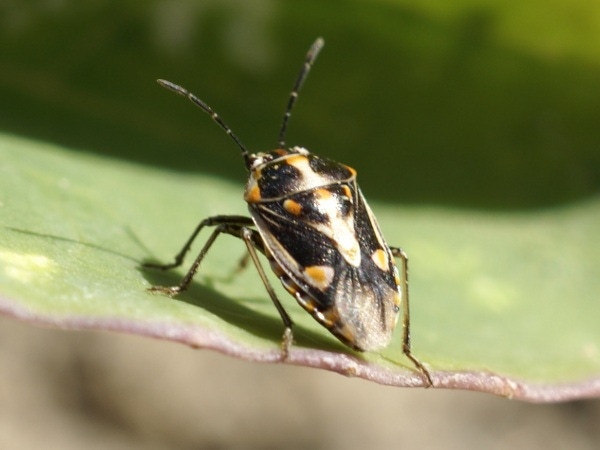October 6, 2010

Bagrada bug update
By John Palumbo, UA Research Scientist and Extension Specialist
Bagrada bug pressure on desert cole crops appears to finally be letting up. Based on trials at the Yuma Agricultural Center (Yuma, Ariz.) and reports from numerous pest control advisers (PCAs) in Coachella, Imperial, Blythe and Yuma, the adult numbers on new stands were much lower last week.
In older stands, the plants now appear to be growing "normally." Insecticide applications are providing longer residual coverage.
In other research trials, soil applied neonicotinoids are providing some relief against adult Bagrada bugs as well. Broccoli plants and cauliflower transplants treated with soil applications of imidacloprid (Admire, Alias, Nuprid, etc) or clothianidin (Belay) at planting are significantly larger than untreated plants at 30 days after the wet date.
Although treated plants at the cotyledon or transplant stages took some damage at stand establishment, it seems that once the plants produced fully expanded leaves that the soil insecticides began to provide protection from Bagrada bugs.
The ultimate impact of the Bagrada bug infestations may not be evident until harvest when we can assess the maturity and quality of the crops that were heavily attacked early in stand establishment.
Although bug numbers have declined, PCAs should remain vigilant and scout fields thoroughly for the presence of adults, and signs of new feeding damage (tattoo-like feeding scars) on cotyledons and young terminal leaves.
YAC research on Bagrada adult activity suggests that adults appear to be most active and abundant on plants in fields during the warmer parts of the day (9:00 - 4:00), and least abundant on the plants early in the morning (4:00 to 8:00). Click on this link, http://extension.arizona.edu/sites/extension.arizona.edu/files/resourcefile/resource/marcop/Bagrada%20bug%20Activity.pdf, for preliminary findings.
The highest probability of finding Bagrada bug adults on plants is during the midday. This may also be the best time to apply insecticides.
Contact Palumbo: (928) 782-3836 or [email protected].
Melon powdery mildew
By Mike Matheron, UA Extension Plant Pathologist
Melon growers need to keep in mind that powdery mildew can occur on fall melons in the desert.
If you have dealt with powdery mildew on spring melons, you will recall that powdery mildew starts off as very small colonies that may be few in number. However, they will continue to grow and produce ever larger quantities of spores, which in turn initiate more infections to bring about a rapid increase in disease symptoms.
In recent fungicide evaluation trials, several fungicides provided excellent control of powdery mildew including Microthiol Disperss (wettable sulfur) Quintec (quinoxyfen), Procure (triflumizole), Rally (myclobutanil), and Endura (boscalid). Thoroughly read the label for each product before use for critical information concerning the chemistry.
Effectively managing powdery mildew with fungicides is best achieved by initial application ideally before the first visible presence of the disease. Subsequent applications of fungicides throughout the life of the crop may be necessary.
The fungus responsible for powdery mildew on melons has developed resistance to some fungicides in the past. Maintaining long-term effectiveness of fungicides currently available requires resistance management strategies. One effective approach is to alternate among products with different modes of action.
The risk of powdery mildew on a particular melon planting is affected by the genetic susceptibility of the melon cultivar to the disease plus air temperatures during the growing season.
Contact Matheron: (928) 726-6856 or [email protected].
Postemergence grass herbicides
By Barry Tickes, UA Area Agriculture Agent
Postemergence grass herbicides have been available for the last 20 to 25 years. These products include fluazifop (Fusilade-1985), sethoxydim (Poast-1986, Segment, Vantage, and others), and clethodim (Select-1991, Select Max, Arrow, Envoy, Volunteer, and others).
These only control grasses and are registered on numerous broadleaf vegetable and field crops plus trees and vines. The herbicides are classified as lipid biosynthesis inhibitors.
The products work by inhibiting the production of an enzyme (ACCase) used to produce fatty acids required for the formation of cell walls and other plant membranes. The herbicides are slow acting and have no soil activity.
Some herbicides use this same mode of action but are used safely on wheat and barley including Discover (clodinafop), Puma (fenoxaprop), and Achieve (tralkoxydim) commonly used to control Canarygrass, wild oat, and other grasses. These herbicides are fairly broad spectrum and control most grasses although there are differences between the products on some weed species.
Clethodim controls sprangletop while sethoxydim and fluazifop do not. The same is true for annual bluegrass which is controlled only by clethodim when small in size. These are weak on sandbur. These herbicides have no soil activity and typically should be applied two to three times to achieve season long weed control.
These herbicides require the use of a crop oil concentrate to help penetrate the leaf surface except for Select Max which requires a non-ionic surfactant or crop oil. These herbicides are normally very safe to the crops for which they are registered.
There have been only a few instances over the past 25 years where crop injury has occurred. One was to melons where above labeled rates of Select Max was applied in overlaps or at the ends of fields. This was only from Select Max.
Another instance was several years ago on onions where liquid fertilizer (AN20) was previously sprayed over the onions for weed control. The third instance was to some leafy vegetables, especially arugula, where the crop oil concentrate caused leaf burn.
Although these herbicides once seemed fool proof, each year more failures are reported. Last year, Poast and Select did not control Rabbitfootgrass in a couple fields and Canarygrass was missed by Poast in others.
The only documented case of herbicide resistance in this region has been the resistance of Canarygrass to sethoxydim, fluazifop, and clethodim in the Imperial Valley.
There are several potential causes for herbicide failures. Resistance is only one and is rare in this region.
Let me know of any failures so we can help determine the cause.
Contact Tickes: (928) 580-9902 or [email protected].
You May Also Like




